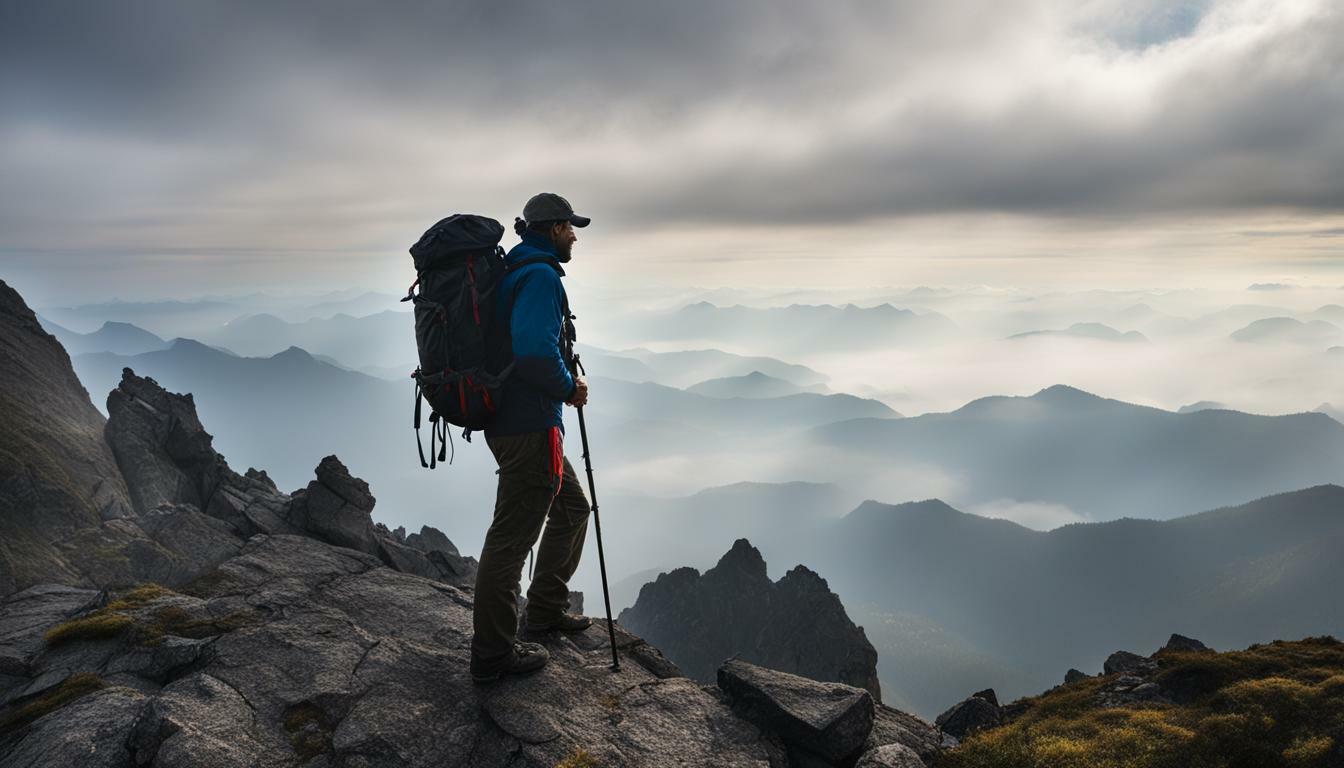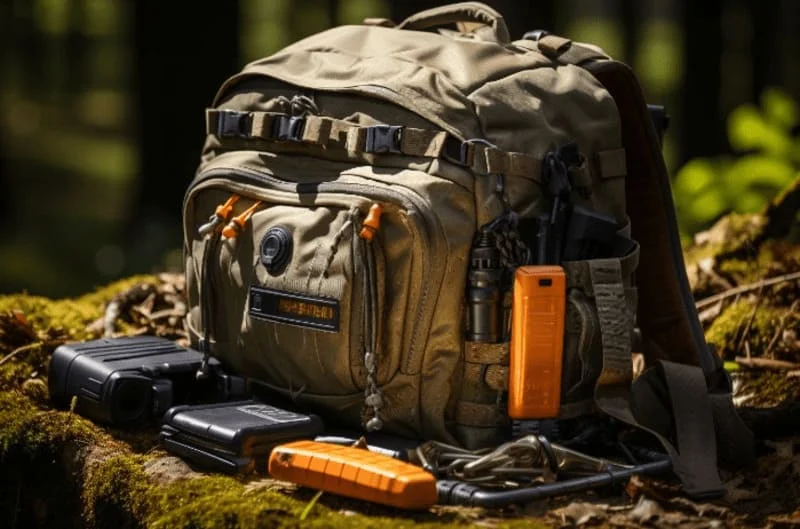Are you ready to dive into the untamed beauty of the wilderness and embark on an unforgettable hiking experience? Hiking safely in the wilderness offers a unique sense of adventure, allowing you to explore untouched nature and discover hidden gems that can only be found off the beaten path.
However, while the wilderness offers endless possibilities, it is important to prioritize safety and be well-prepared for the challenges that may arise. In this guide, I will provide you with valuable tips and insights to ensure that your wilderness hiking journey is not only thrilling but also safe and enjoyable.
15 Key Takeaways:
- Prepare yourself for outdoor adventures in the wilderness
- Discover the beauty and unique experiences of wilderness hiking
- Equip yourself with the essential gear for a safe hiking experience
- Learn how to navigate with maps and GPS devices in the wilderness
- Understand the importance of safety precautions and emergency preparedness
- Stay hydrated and properly store food in the wilderness
- Choose the right hiking trail and destination for your skill level
- Minimize wildlife encounters and know how to handle them safely
- Promote responsible behavior in the wilderness
- Be prepared for various weather conditions during your hike
- Reap the physical, mental, and emotional benefits of hiking in the wilderness
- Plan and prepare for overnight wilderness backpacking trips
- Take precautions when hiking alone in the wilderness
- Embark on off-grid hiking experiences in untouched wilderness
- Embrace the thrill of nature exploration and adventure in the wilderness
The Beauty of Wilderness Hiking
When it comes to hiking, there’s something truly special about venturing into the wilderness. It’s a chance to escape the hustle and bustle of everyday life and immerse yourself in the wonders of nature. Hiking in the wilderness offers a unique and breathtaking experience that simply can’t be replicated in any other setting.
“Spending time in nature is full of wonder, with a lot of outdoor magic stemming from wildlife sightings. Watching birds of prey soar high above a meadow of grazing bison can stop you in your tracks. But the sense of peace you might experience around wildlife is only because there is a safe distance between you and the animals.”
Undoubtedly, one of the most appealing aspects of wilderness hiking is the opportunity to explore untouched landscapes. Picture yourself walking along rugged trails, surrounded by towering trees, majestic mountains, and pristine lakes. The sense of awe and wonder that comes from witnessing the untouched beauty of the wilderness is unparalleled.
Wilderness hiking offers a chance to reconnect with nature and reinvigorate the soul.
As you venture deeper into the wilderness, you’ll discover hidden gems that few have had the privilege of seeing. From secluded waterfalls to hidden caves, the wilderness is a treasure trove of natural wonders just waiting to be explored.
The Thrill of Nature Exploration
Exploring the wilderness allows you to tap into your sense of adventure and push your limits. Each step you take is a step into the unknown, filled with excitement and anticipation. You never know what you might encounter on your journey – a rare bird perched in a tree, a group of grazing deer, or even the elusive tracks of a wild animal.
Whether you’re hiking along winding trails or venturing off the beaten path, the wilderness offers endless opportunities for discovery. With each new trail comes a new adventure, and the possibilities are as vast as the wilderness itself.
Hiking in the wilderness also provides a sense of solitude and tranquility that is increasingly rare in today’s fast-paced world. It’s a chance to disconnect from technology and reconnect with your inner self. In the wilderness, the only sounds you’ll hear are the rustling of leaves, the chirping of birds, and the rushing of water. It’s a welcome respite from the noise and distractions of everyday life.
The beauty of wilderness hiking lies in the simplicity of being surrounded by nature and immersing yourself in its wonders.
Whether you’re an experienced hiker or new to the world of wilderness exploration, there’s something for everyone in the great outdoors. So lace up your hiking boots, pack your backpack, and embark on an adventure that will leave you with memories to last a lifetime.
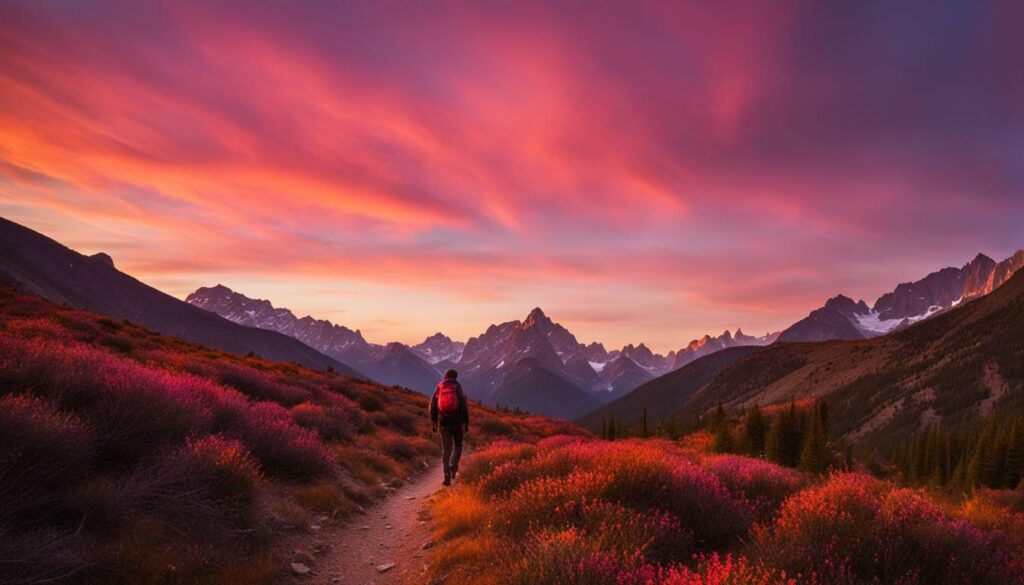
Essential Hiking Gear for Hiking Safely in the Wilderness
When embarking on a wilderness hiking adventure, having the right gear is essential for your safety, comfort, and enjoyment. Here are some must-have items to include in your backpack:
Hiking Backpack
A sturdy and well-fitted hiking backpack is crucial for carrying all your gear. Look for one with adjustable straps and multiple compartments to distribute weight evenly and keep your essentials organized.
Hiking Boots
Investing in a pair of high-quality hiking boots is essential for tackling rugged terrain. Look for boots that offer ankle support, traction, and waterproof features to keep your feet dry and protected.
Moisture-Wicking Clothing
Opt for moisture-wicking clothing that helps regulate your body temperature and keeps you dry as you work up a sweat. Avoid cotton as it retains moisture and can leave you feeling uncomfortable and cold.
Waterproof Jacket
A waterproof jacket is a must-have for unexpected weather conditions. Look for a lightweight and breathable option that can withstand rain, wind, and other elements.
Hat, Sunglasses, and Sunscreen
Protect yourself from the sun’s harmful rays by wearing a hat, sunglasses, and sunscreen. Choose a wide-brimmed hat that provides shade and sunglasses with UV protection for your eyes.
Insect Repellent
Keep pesky bugs at bay with insect repellent. Look for a formula that is effective against mosquitoes, ticks, and other biting insects.
Remember, while having the right gear is crucial, it’s also important to pack light and only bring the essentials to avoid unnecessary weight. Additionally, make sure to test out and break in your gear before your hiking trip to ensure comfort and functionality.
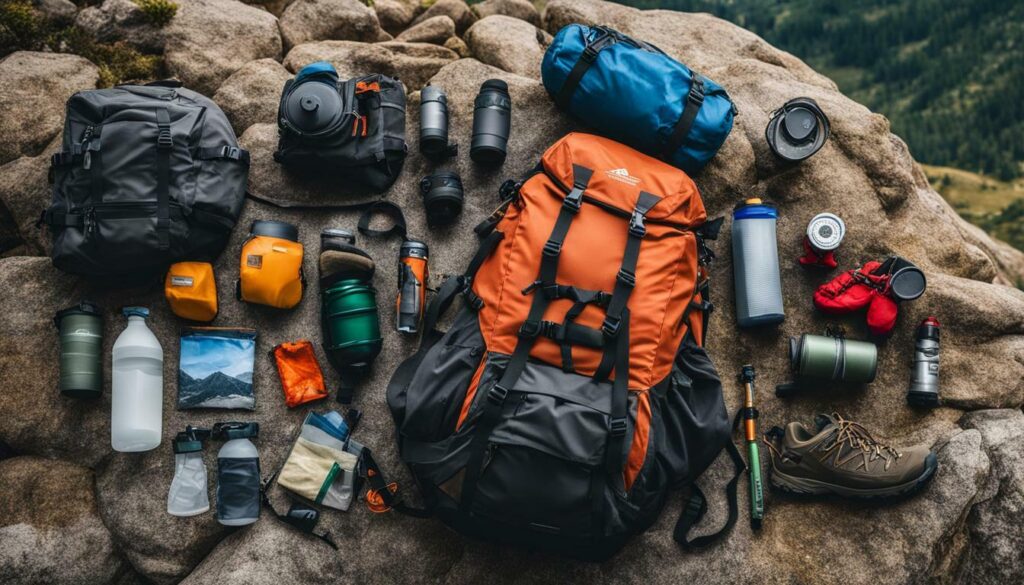
Now that you’re equipped with the essential hiking gear, you’re ready to hit the wilderness and embark on your adventure! Stay tuned for the next section of our guide, where we’ll discuss how to navigate the wilderness using maps and GPS devices.
Section 4: Navigating with Maps and GPS Devices
When venturing into the wilderness, having the ability to navigate your way through the terrain is crucial for a safe and enjoyable hiking experience. While exploring wilderness trails, you can rely on traditional navigation tools such as maps and compasses, as well as modern GPS devices to keep you on track. Here are some tips on how to effectively navigate with maps and GPS devices:
Using Maps
Maps are an essential tool for wilderness hiking, providing a visual representation of the trails, landmarks, and topography of the area you are exploring. Here’s how to make the most of your map:
- Choose a detailed and up-to-date topographic map that covers your hiking destination. Topographic maps provide information on the elevation, contours, water sources, and other important features of the terrain.
- Study the map before your hike to familiarize yourself with the trail routes, potential hazards, and points of interest along the way.
- Use a map case or a waterproof sleeve to protect your map from moisture and damage, ensuring it remains readable throughout your hike.
- Orient the map correctly by aligning it with the surrounding landscape using a compass or by matching identifiable features on the map with those in your surroundings.
- Trace your progress on the map as you hike, marking key landmarks or intersections to keep track of your location and progress.
Utilizing GPS Devices
GPS devices have revolutionized wilderness navigation, providing hikers with accurate positioning, route tracking, and other helpful features. Here’s how to make the most of your GPS device:
- Choose a reliable and durable GPS device designed for outdoor use. Ensure that it has a strong satellite signal reception and long-lasting battery life.
- Download or pre-load detailed maps of your hiking area onto your GPS device. These maps should include trails, waypoints, and other relevant information.
- Learn how to operate your GPS device, including how to mark waypoints, track your route, and navigate to specific coordinates.
- Carry spare batteries or a portable charger to ensure your GPS device remains powered throughout your hike.
- Use the GPS device as a complement to your map and compass, rather than relying on it solely. GPS signals can be affected by environmental factors, so it’s important to cross-reference with other navigation tools.
Note: While GPS devices provide convenience and accuracy, it’s important to maintain your map and compass skills as a backup in case of device failure or signal loss.
By combining the use of maps and GPS devices, you can navigate the wilderness confidently and efficiently, ensuring you stay on the right trail and reach your desired destinations. Remember to always carry a map and compass as a backup and be prepared to navigate using traditional methods if needed. Happy exploring!
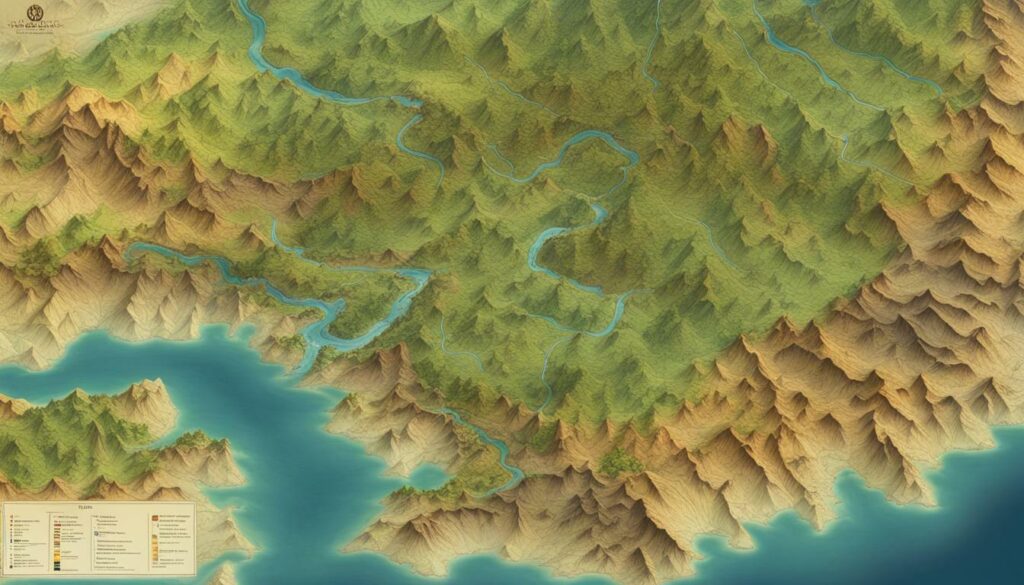
Safety Precautions and Emergency Preparedness
When hiking in the wilderness, it is crucial to prioritize safety and be prepared for any emergencies that may arise. By taking necessary precautions and having the right gear, you can ensure a safer and more enjoyable hiking experience. Here are some essential safety tips and emergency preparedness measures to consider:
Carry a First-Aid Kit
Always have a well-stocked first-aid kit with you. It should include bandages, antiseptic ointment, pain relievers, adhesive tape, and any necessary prescription medications. Additionally, consider taking a wilderness first-aid course to learn basic medical skills.
Bring an Emergency Whistle and Headlamp
In case of an emergency, an emergency whistle can be a lifesaver. It can be heard from a long distance and can attract attention if you need help. Additionally, bring a headlamp with extra batteries to ensure you have a reliable source of light, especially if you end up hiking after dark.
Carry Fire Starting Tools
Having a fire starter and waterproof matches in your backpack can be crucial in emergency situations. They can help provide warmth, signal for help, and cook food if needed. Make sure to practice proper fire safety and check local regulations regarding fires before starting one.
Stay Oriented with a Map and Compass (or GPS)
While modern GPS devices can be reliable, it’s essential to have a backup navigation system. Carry a map of the area you’re hiking in and a compass to help you stay on track. Familiarize yourself with how to use them before your hike.
Know Your Limits and Turn Back if Necessary
Don’t push yourself beyond your physical capabilities. If you start feeling exhausted, injured, or unwell, it’s important to listen to your body and consider turning back. Continuing on when you’re not at your best can lead to accidents and further health risks.
Inform Someone of Your Plans
Before heading into the wilderness, let someone reliable know about your hiking plans. Share details such as the trail you’ll be hiking, the expected duration of your trip, and when you plan to return. This will help rescuers locate you if you don’t return as scheduled.
Be Prepared for Changing Weather Conditions
Weather in the wilderness can be unpredictable, so it’s crucial to be prepared for any changes. Pack extra layers for insulation, a rain cover for your backpack to protect your gear, and appropriate gear for hot or cold weather. Stay updated on weather forecasts before your hike and be ready to adjust your plans if needed.
Remember, emergencies can happen even to the most experienced hikers. By following safety precautions and being well-prepared, you can minimize risks and enjoy your wilderness hiking adventure to the fullest.
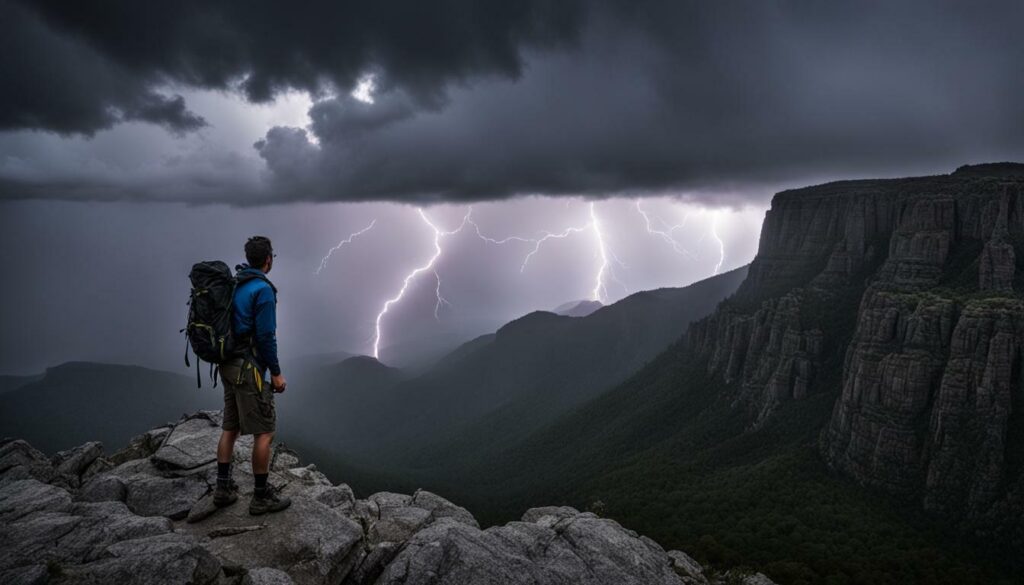
Water and Food Considerations
When embarking on a wilderness hiking adventure, it’s crucial to prioritize your water and food needs. Proper hydration and nutrition are essential for maintaining energy and stamina during long hikes. Here are some important considerations for water and food while hiking in the wilderness:
Carrying Sufficient Water
Water is your lifeline in the wilderness, so it’s vital to carry enough to stay hydrated throughout your hike. Invest in durable and lightweight water bottles that can be easily refilled along the trail. Aim to drink at least half a liter of water per hour, and adjust this amount based on the intensity of your hike and weather conditions.
Additionally, it’s wise to bring water purification tablets to ensure safe drinking water from natural sources such as streams or lakes. Simply follow the instructions on the tablets to make water safe for consumption.
Properly Storing Food
When it comes to food storage in the wilderness, it’s important to prevent unwanted encounters with wildlife, particularly bears. Invest in a bear-resistant food container to store your food securely. These containers are designed to withstand the strength and persistence of bears, keeping both you and the wildlife safe.
Using Bear Spray
Bear encounters are rare, but it’s essential to be prepared and know how to handle such situations. Carry bear spray, which is a potent deterrent in case of an aggressive bear approaching. Familiarize yourself with how to properly use bear spray before your hike, making sure it is easily accessible in case of an emergency.
Portable Toilet Paper and Trowel
When nature calls in the wilderness, it’s important to practice proper Leave No Trace principles. Carry portable toilet paper and a trowel to bury human waste at least 6-8 inches deep and 200 feet away from water sources. This helps maintain the pristine beauty of the wilderness and prevents contamination.
Personal Hygiene Matters
Staying clean and practicing good personal hygiene is crucial for overall well-being during a wilderness hike. Carry wet wipes or biodegradable soap to clean your hands and face regularly. This helps prevent the spread of bacteria and keeps you feeling refreshed.
Remember, responsible water and food practices are essential for preserving the wilderness and ensuring a safe and enjoyable hiking experience. By following these considerations, you can stay hydrated, nourished, and minimize your impact on the environment.

Choosing the Right Hiking Trail and Destination
When it comes to hiking in the wilderness, one of the most important factors to consider is choosing the right trail and destination. With so many options available, it can be overwhelming to decide where to go. But fear not, as I’ll provide you with some helpful tips to make this decision easier.
Research Different Hiking Trails
The first step in choosing the right hiking trail is to do thorough research. Look for hiking trails that match your skill level, time constraints, and personal preferences. Consider factors such as distance, elevation gain, terrain difficulty, and weather conditions. Websites and apps dedicated to hiking trails, like AllTrails or Hiking Project, can be valuable resources for finding detailed information and user reviews.
Consider the Best Hiking Spots
Next, consider some of the best hiking spots in the wilderness. These spots are renowned for their scenic beauty, unique features, and memorable experiences. National parks, state parks, and wilderness areas often offer a variety of hiking trails that cater to different preferences. Some popular hiking destinations include Yosemite National Park, the Appalachian Trail, the Grand Canyon, and the Pacific Crest Trail.
Explore Nature Trails and Wilderness Areas
If you prefer a more secluded and off-the-beaten-path experience, consider exploring nature trails and wilderness areas. These areas offer a chance to immerse yourself in untouched wilderness and enjoy a deeper connection with nature. Research local wilderness areas and nature reserves in your region, or consider venturing to remote locations known for their pristine beauty and solitude.
Seek Recommendations and Reviews
Another useful strategy for choosing the right hiking trail and destination is seeking recommendations and reading reviews from fellow hikers. Online hiking communities, forums, and social media groups can be a great source of information and firsthand experiences. Ask for recommendations, share your preferences, and gather valuable insights from those who have hiked the trails you’re interested in.
Consider Your Fitness Level and Experience
Remember to consider your own fitness level and hiking experience when choosing a trail. If you’re a beginner hiker, opt for shorter and less strenuous trails that are suitable for your fitness level. Gradually increase the difficulty as you gain more experience and confidence. It’s essential to challenge yourself but also to ensure your safety and enjoyment while hiking in the wilderness.
Plan According to the Season and Weather
Lastly, consider the season and weather conditions when planning your hiking trip. Different trails and destinations have varying conditions throughout the year, so research the best time to visit. Take into account factors such as temperature, precipitation, trail access, and wildlife activity. Keep in mind that certain trails may require permits or have restricted access during specific seasons.
By following these tips and considering your personal preferences, you’ll be well on your way to choosing the right hiking trail and destination for your wilderness adventure. Whether you prefer majestic national parks, secluded nature trails, or off-the-grid wilderness areas, there’s a perfect hiking spot out there waiting for you to explore.
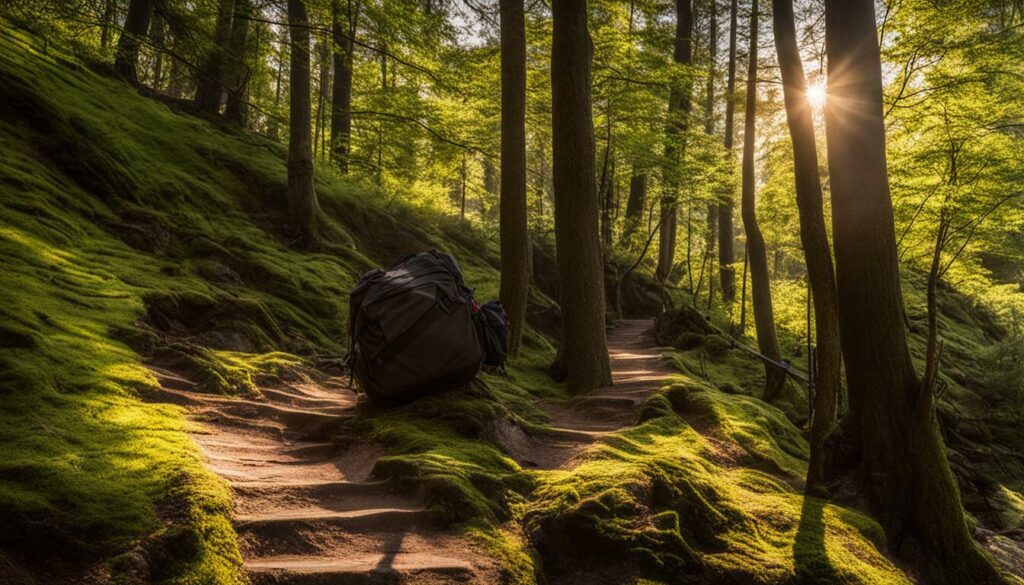
Wildlife Encounters and Safety Measures
When hiking in the wilderness, encountering wildlife can be an awe-inspiring experience. However, it’s important to remember that wildlife is, indeed, wild, and it’s crucial to take precautions to ensure both your safety and the well-being of the animals. Here are some wildlife encounters tips and safety measures to keep in mind:
Minimizing Unwanted Wildlife Encounters
Before we delve into what to do if you encounter different species of wildlife, let’s discuss some actions you can take to minimize unwanted wildlife encounters in the first place:
- Make Noise: When hiking in bear or cougar country, it’s crucial to make noise to alert animals of your presence. Talk, sing, or carry a small musical instrument to create sound at regular intervals. This will help prevent sneaking up on wildlife and give them an opportunity to retreat.
- Avoid Dawn or Dusk Hiking: Animals are most active during dawn and dusk, so it’s best to plan your hikes during other times of the day. If you do venture out during these hours, be extra cautious and inform someone of your plans.
- Properly Store Food: To avoid attracting wildlife to your campsite, store all food in containers designed for this purpose. If you’re in bear country, use bear-resistant containers. This includes not only food but also trash bags, cookware, and anything else with food odors.
- Don’t Feed the Animals: While it may seem tempting to feed wild animals, it is harmful to their health and well-being. Feeding them can disrupt their natural feeding patterns and lead to dependence on human food, creating future problems for both animals and humans. Remember, they have their own sources of food in the wild.
What to Do if You Encounter Wildlife
Despite your best efforts, there may still be instances where you encounter wildlife while hiking in the wilderness. Here are some guidelines for dealing with different animals:
Cougars and Mountain Lions
Encounters with cougars and mountain lions are rare, but it’s essential to know how to react if you come face-to-face with one:
- Never approach the animal: Stay calm and back away slowly.
- Make yourself look bigger: Raise your arms above your head, and if you have extra clothing, hold it up to make yourself appear larger.
- Speak firmly: Talk to the cougar in a firm and confident voice, letting it know that you are a human.
- Be prepared to defend yourself: If the cougar shows signs of aggression, yell, throw rocks, or use any objects within reach to deter the animal.
Moose
Moose encounters are more common than you might think. Here’s what to do if you encounter a moose:
- Remain calm: Speak softly to the moose and avoid sudden movements.
- Back away slowly: Give the moose plenty of space and time to move away.
- Don’t provoke: If the moose shows signs of aggression (ears laid back, raised hair), move even more slowly and avoid eye contact.
Bears
Encountering a bear can be both thrilling and potentially dangerous. Here are some tips for handling bear encounters:
- Stay calm: Don’t run or make sudden movements. Back away slowly, keeping your eyes on the bear.
- Use bear spray: If you have bear spray, have it in your hand and be prepared to use it if necessary.
- Make yourself look bigger: Stand tall, raise your arms, and try to appear as large as possible.
- Speak calmly: Talk to the bear in a calm and assertive voice, letting it know that you are a human.
- Never approach a bear: Maintain a safe distance and never approach a bear, especially if it has cubs.
Snakes
While snakes generally prefer to avoid human encounters, it’s essential to be cautious and know what to do if you encounter one:
- Back away slowly: Give the snake plenty of space and slowly retreat from the area.
- Be aware of your surroundings: Keep an eye out for snake habitats such as rocks, fallen trees, or tall grass.
- Stay calm: If you get bitten by a snake, stay calm, clean the wound with soap, and seek medical attention immediately.
Hiking Responsibly in Wildlife Areas
When hiking in wildlife areas, it’s vital to remember that we are guests in their natural habitat. Here are some additional tips for hiking responsibly:
- Stay on designated trails: Stick to established trails to minimize your impact on wildlife habitats and avoid disturbing nesting or resting animals.
- Observe from a distance: Use binoculars or a zoom lens to get a closer look at wildlife instead of approaching too closely.
- Follow regulations: Be aware of any specific regulations for the area you’re hiking in, such as restrictions on off-trail hiking or the use of bear-resistant containers.
- Leave no trace: Pack out all your trash, respect the environment, and avoid leaving any traces of your presence behind.
Hiking in the wilderness provides incredible opportunities to witness and appreciate the natural wonders of wildlife. By following these safety measures and responsible hiking practices, we can ensure the well-being of both ourselves and the wildlife that call these areas home.

Enjoying the Wilderness Responsibly
When embarking on a wilderness hiking adventure, it is crucial to embrace responsible behavior. By following ethical guidelines and practicing Leave No Trace principles, we can ensure the preservation of these pristine environments for future generations to enjoy.
Here are some tips for enjoying the wilderness responsibly:
- Plan ahead: Before setting out on your hike, research the area, familiarize yourself with local regulations, and obtain any necessary permits. This will help minimize your impact on the environment and ensure you are well-prepared for the journey ahead.
- Stick to designated trails: Stay on established trails to avoid trampling fragile vegetation and disturbing wildlife habitats. Straying off the path can cause irreversible damage to the ecosystem.
- Leave No Trace: Carry out everything you bring into the wilderness, including garbage and waste. Pack a portable toilet paper and trowel for bathroom needs, and dispose of waste properly in designated receptacles.
- Respect wildlife: Keep a safe distance from wildlife and observe them from afar. Do not feed or approach animals as it disrupts their natural behaviors and can pose risks to both humans and animals.
- Minimize noise: Be mindful of the volume of your voice and any noises you create. Excessive noise can disturb wildlife and disrupt the tranquility of the wilderness for other hikers.
- Camp responsibly: Choose designated camping areas and follow guidelines for setting up tents and campfires. Use existing fire rings and be mindful of fire safety precautions to prevent forest fires.
- Respect other hikers: Share the trail with courtesy and respect for fellow hikers. Yield to uphill hikers, keep noise levels down, and avoid overcrowding at scenic viewpoints.
“The wilderness holds answers to questions we have not yet learned to ask.” – Nancy Newhall
By embracing these practices, we can ensure that the beauty and serenity of the wilderness remains intact for generations to come. Let’s be responsible stewards of these precious natural treasures and continue to enjoy the wonders of outdoor adventure and wilderness hiking.

Hiking Safety Tips for Various Weather Conditions
When embarking on a wilderness hiking adventure, it’s crucial to be prepared for any weather conditions you may encounter along the way. The wilderness can be unpredictable, so having the right gear and knowledge is essential for a safe and enjoyable hike. Here are some hiking safety tips for various weather conditions:
Hiking in Cold Weather:
When hiking in cold weather, it’s important to dress in layers to regulate your body temperature. Here are some essential items to pack:
- Insulation Layers: Wear moisture-wicking base layers, fleece or down jackets, and thermal pants to keep warm.
- Waterproof and Windproof Gear: Invest in a waterproof and windproof jacket and pants to protect yourself from the elements.
- Warm Hat, Gloves, and Socks: Keep your extremities warm by wearing a hat, gloves, and thick wool socks.
- Rain Cover for Backpack: Make sure your backpack has a rain cover to protect your gear from getting wet.
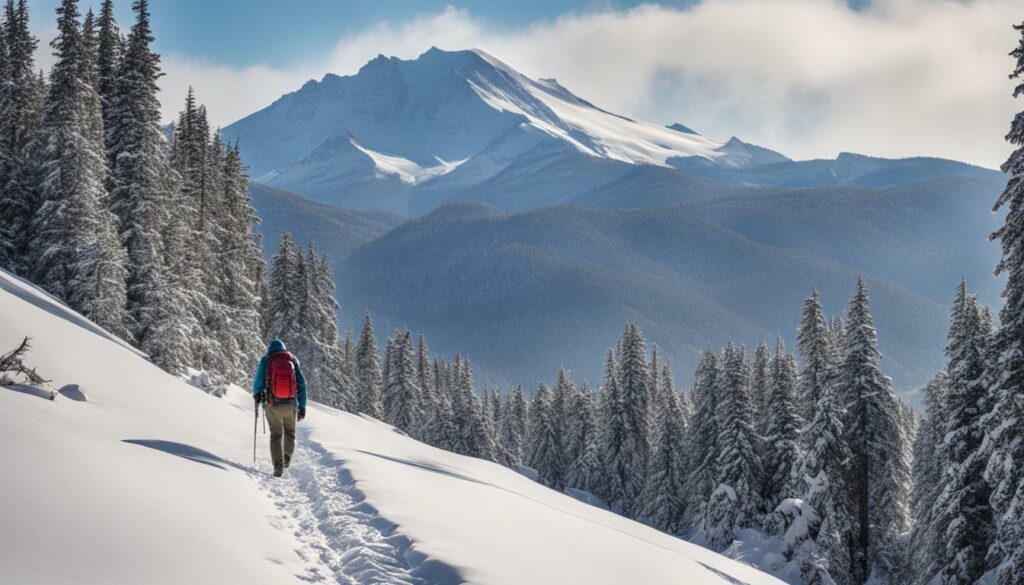
“No weather is inclement if one is properly dressed.” – Sir Ranulph Fiennes
Hiking in Rainy Weather:
When hiking in rainy conditions, staying dry is essential to prevent hypothermia. Here’s what you need:
- Waterproof Jacket and Pants: Invest in high-quality rain gear that is both waterproof and breathable.
- Waterproof Hiking Boots: Ensure your boots are waterproof to keep your feet dry and comfortable.
- Extra Dry Clothes: Pack an extra set of dry clothes in a waterproof bag to change into if you get wet.
- Rain Cover for Backpack: Protect your gear by using a rain cover for your backpack.
Hiking in Hot Weather:
When hiking in hot weather, it’s important to protect yourself from the sun and stay hydrated. Here’s what you need:
- Moisture-Wicking Clothing: Wear lightweight and breathable clothing that wicks away sweat.
- Hat and Sunglasses: Protect your face and eyes from the sun’s rays by wearing a hat and sunglasses.
- Sunscreen: Apply sunscreen with a high SPF to protect your skin from harmful UV rays.
- Insect Repellent: Apply insect repellent to prevent bug bites.
- Hydration: Carry enough water and consider using a hydration pack to stay hydrated.
Remember, it’s crucial to check the weather forecast before your hike and be prepared for changing conditions. Always prioritize your safety and adjust your plans accordingly. By following these hiking safety tips, you’ll be well-prepared for a safe and enjoyable wilderness hiking experience in any weather.
Benefits of Hiking in the Wilderness
Nature’s Playground: Outdoor Adventures
One of the greatest benefits of hiking in the wilderness is the opportunity for outdoor adventures. The untouched beauty of remote hiking experiences allows you to immerse yourself in nature like never before. As you traverse rugged trails and explore hidden destinations, you’ll feel a sense of freedom and exhilaration that can only be found in the wilderness.
Escape the Ordinary: Wilderness Hiking
Wilderness hiking takes you far away from the distractions and monotony of everyday life. It offers a chance to disconnect from technology and reconnect with the natural world. The solitude and serenity found in untouched wilderness provide a much-needed escape, allowing you to clear your mind and find inner peace.
Unforgettable Memories: Remote Hiking Experiences
Hiking in the wilderness creates memories that last a lifetime. Whether it’s conquering a challenging trail, witnessing a breathtaking sunrise over a mountaintop, or encountering wildlife in its natural habitat, these experiences leave a lasting impact on your mind and soul. Remote hiking experiences offer a sense of achievement and fulfillment that few other activities can match.
So, if you’re seeking outdoor adventures, a break from the ordinary, and the opportunity to make unforgettable memories, wilderness hiking is the perfect choice for you. Lace up your hiking boots, pack your backpack, and embark on a journey to unleash your true adventure in the untouched beauty of the wilderness.

Planning for Overnight Wilderness Backpacking
When embarking on an overnight wilderness backpacking trip, proper planning and preparation are crucial to ensure a safe and enjoyable experience. Here are the essential items you need to pack:
1. Sleeping Bag
A high-quality sleeping bag is essential to keep you warm and comfortable during the chilly nights in the wilderness. Choose a bag that is suitable for the expected weather conditions and temperature range of your hiking destination.
2. Tent
A reliable tent provides shelter and protection from the elements. Look for a lightweight, waterproof tent that is easy to set up and durable enough to withstand rough terrain.
3. Portable Toilet Paper and Trowel
Proper waste disposal is crucial when camping in the wilderness. Pack portable toilet paper and a trowel to dig cat holes for burying human waste. This helps to minimize environmental impact and maintain cleanliness.
4. Personal Hygiene Items
While backpacking in the wilderness, it’s essential to maintain personal hygiene. Pack travel-sized toiletries, such as biodegradable soap, toothbrush, toothpaste, and hand sanitizer. These items will help you stay clean and prevent the spread of germs.
5. Extra Clothing
It’s vital to pack extra clothing layers for overnight backpacking trips. Weather conditions can change rapidly in the wilderness, so be prepared for temperature fluctuations. Pack lightweight, moisture-wicking clothing that can be layered for warmth.
6. Rain Cover for Backpack
To protect your gear from rain and moisture, pack a rain cover specifically designed for your backpack. This will keep your belongings dry and prevent water damage to essential items.
7. Navigation Tools
Don’t forget to bring a map, compass, or GPS device to navigate your way through the wilderness. These tools will help you stay on track and prevent getting lost in unfamiliar terrain.
8. Lighting and Fire Starting Tools
A reliable headlamp with extra batteries is essential for nighttime navigation and campsite activities. Additionally, pack fire starting tools like waterproof matches or a firestarter kit to ensure you can start a fire for warmth and cooking.
9. Water Purification
Water is essential for survival, so pack water purification tablets or a water filter to ensure a safe and clean water source. This will eliminate the need to carry heavy water bottles and allow you to replenish your water supply from natural sources.
10. Bear-Resistant Food Container
When backpacking in bear country, it’s crucial to store your food securely to prevent attracting wildlife. Invest in a bear-resistant food container to protect your food and keep both you and the bears safe.
11. Bear Spray
In addition to a bear-resistant food container, it’s advisable to carry bear spray as a precautionary measure. Bear spray is a deterrent that can be used to ward off aggressive bears and ensure your safety.
By packing these essential items, you’ll be well-prepared for a safe and enjoyable overnight wilderness backpacking adventure. Remember to always check the local regulations and guidelines specific to your hiking destination and be mindful of Leave No Trace principles to minimize your environmental impact.

“Proper planning and preparation are crucial to ensure a safe and enjoyable experience during overnight wilderness backpacking.”
Tips for Hiking Alone in the Wilderness
Hiking alone in the wilderness can be a thrilling and rewarding experience. It allows you to connect with nature on a deeper level and find solace in the peacefulness of untouched landscapes. However, hiking alone also comes with its own set of challenges and risks. Here are some wilderness hiking tips to ensure your safety and enhance your outdoor adventure:
- Inform someone of your plans: Before embarking on a solo hike, let someone reliable know about your itinerary. Share details such as the trail you’ll be hiking, the estimated duration of your hike, and when you expect to return. This way, if something goes wrong or you don’t return on time, someone will know to raise the alarm and can assist in search and rescue efforts.
- Research the trail: Before setting out, thoroughly research the trail you’ll be hiking. Study maps, read trail descriptions, and familiarize yourself with any potential hazards or challenging sections. Knowing what to expect will help you better prepare and make informed decisions along the way.
- Bring essential gear: Make sure you have all the necessary gear for a safe wilderness hiking experience. This includes a backpack, hiking boots, moisture-wicking clothing, a waterproof jacket, a hat, sunglasses, sunscreen, and insect repellent. Be prepared for changing weather conditions by layering your clothing and carrying extra insulation layers. Don’t forget to pack a map, compass, or GPS device, as well as a first-aid kit, an emergency whistle, a headlamp with extra batteries, a fire starter, waterproof matches, a lightweight stove, fuel, water bottles, water purification tablets, a sleeping bag, a tent, a bear-resistant food container, bear spray, portable toilet paper, a trowel, and personal hygiene items.
- Know your limits: Be honest with yourself about your physical fitness and hiking abilities. Choose a trail and pace that align with your skill level and experience. Pushing yourself too hard or attempting hikes beyond your capabilities can increase the risk of accidents or injuries. Remember, it’s better to start with easier trails and gradually progress to more challenging ones.
- Stay on the trail: Stick to marked trails and avoid venturing off the designated path. Straying from the trail can lead to getting lost or disturbing delicate ecosystems. If you do need to leave the trail temporarily, ensure you have good navigation skills and can easily find your way back.
- Be aware of wildlife: In the wilderness, you may encounter various wildlife species. While most animals will prefer to avoid human contact, it’s essential to know how to react if you come across wildlife. Familiarize yourself with the behavior and habits of animals in the area you’ll be hiking and follow recommended safety precautions. Keep a safe distance, avoid sudden movements, and never feed or approach wild animals.
Remember, hiking alone in the wilderness requires careful planning, preparation, and a responsible mindset. By following these wilderness hiking tips, you can have a safe and enjoyable outdoor adventure while embracing the solitude and beauty of nature.
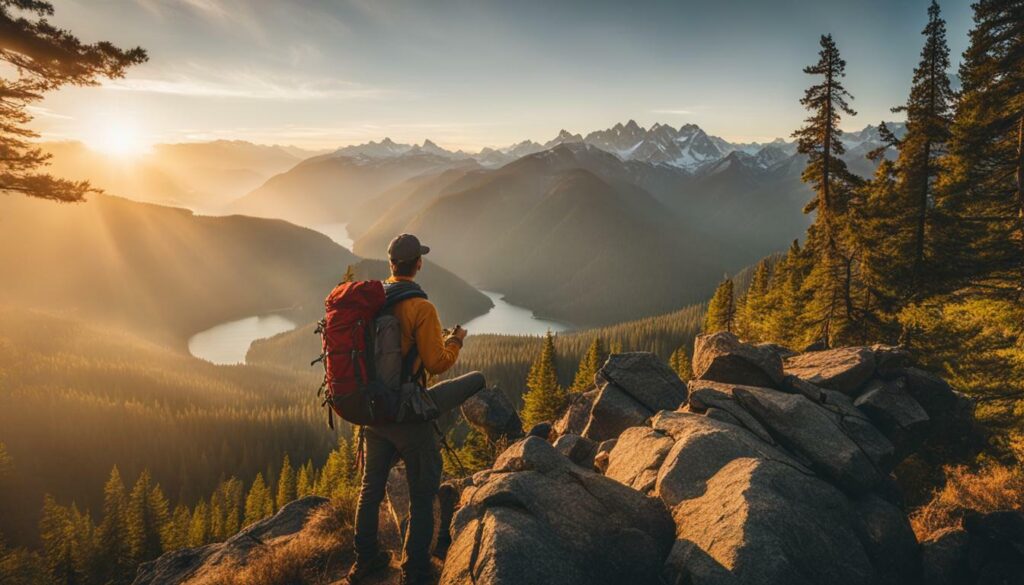
Exploring Untouched Wilderness: Off-Grid Hiking Experiences
Welcome to the ultimate adventure for outdoor enthusiasts – off-grid hiking in untouched wilderness. If you’re seeking a truly immersive and exhilarating experience in nature, then look no further. Off-grid hiking takes you deep into remote and pristine landscapes, far away from the hustle and bustle of modern life. It’s an opportunity to disconnect from technology, reconnect with nature, and unleash your inner explorer.
Off-grid hiking offers the chance to discover hidden gems and untouched wilderness that few have experienced. You’ll traverse rugged terrain, navigate through dense forests, cross crystal-clear streams, and summit majestic peaks. Every step will bring you closer to the raw beauty of nature, where you can witness breathtaking landscapes and encounter diverse wildlife.
What sets off-grid hiking apart is the sense of self-sufficiency and independence it fosters. You’ll carry everything you need on your back, enabling you to truly immerse yourself in the wilderness. From setting up camp in secluded spots to cooking meals over a campfire, every aspect of off-grid hiking is an adventure in itself.
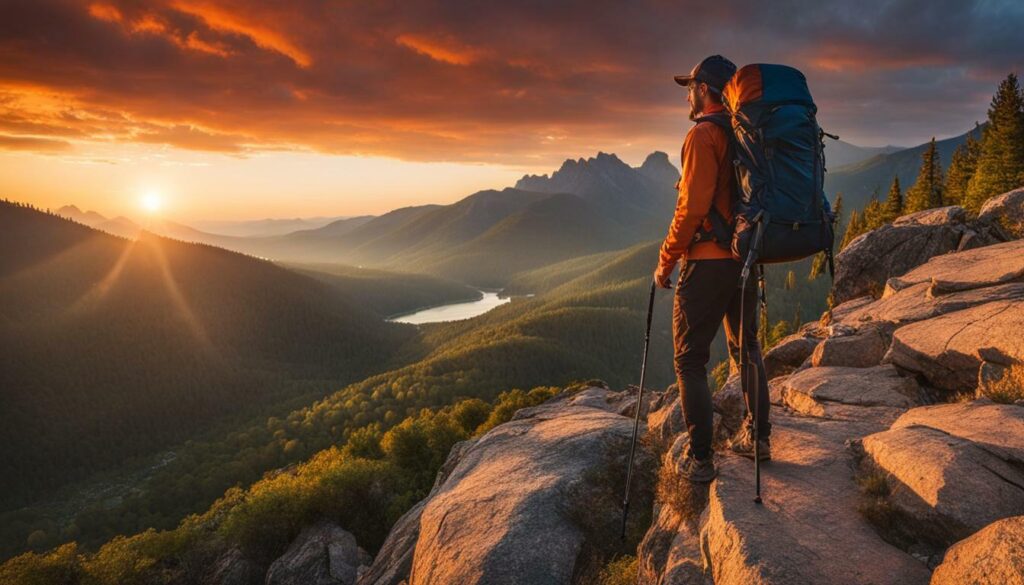
Off-grid hiking requires careful planning and preparation to ensure your safety and enjoyment. Here are some essential tips to make the most of your off-grid hiking experience:
- Research and choose a remote hiking destination that aligns with your skill level and preferences. Whether it’s exploring dense forests, traversing vast deserts, or conquering challenging mountain ranges, there’s a wilderness waiting for you.
- Invest in high-quality hiking gear, including a sturdy backpack, reliable hiking boots, moisture-wicking clothing, and a waterproof jacket. These essentials will keep you comfortable and protected throughout your journey.
- Pack essential survival tools, such as a map, compass, and GPS device, to navigate the wilderness effectively. Familiarize yourself with the trail and have a backup plan in case of unexpected circumstances.
- Take safety precautions seriously. Pack a first-aid kit, an emergency whistle, a headlamp with extra batteries, a fire starter, and waterproof matches. These items can make a significant difference in emergencies.
- Ensure you have enough food and water for the duration of your hike. Pack lightweight and nutrient-rich meals that are easy to prepare. Use water purification tablets or a portable water filter to stay hydrated.
- Respect the wildlife and follow Leave No Trace principles. Keep a safe distance from animals, never feed them, and store your food securely to prevent unwanted encounters.
- Be prepared for varying weather conditions. Layer your clothing for insulation, carry a rain cover for your backpack, and pack a hat, sunglasses, and sunscreen to protect yourself from the sun.
Remember, off-grid hiking is a privilege that comes with responsibilities. Leave the wilderness as you found it, respecting its natural beauty and preserving it for future generations. By embracing the challenges and wonders of off-grid hiking, you’ll unlock a world of adventure and create memories that will last a lifetime.
Embrace the Wilderness and Unleash Your True Adventure
As an avid hiker, I can attest to the transformative power of exploring the wilderness. There’s something magical about immersing yourself in untouched nature, disconnecting from the noise of everyday life, and embarking on an adventure that pushes you to your limits. Hiking in the wilderness allows you to experience the beauty of our natural world, challenge yourself physically and mentally, and reconnect with your true self.
But, as exhilarating as wilderness hiking can be, it’s important to prioritize safety. The wilderness can be unpredictable, and being prepared is key to ensuring a safe and enjoyable experience. From the essential gear you’ll need to navigating with maps and GPS devices, here are some tips to help you hike safely in the wilderness.
Essential Hiking Gear for the Wilderness
Before setting off on your wilderness adventure, make sure you have the right gear to keep you safe and comfortable. A sturdy backpack is essential for carrying all your necessities, and investing in a pair of durable hiking boots will provide stability and support on rugged terrain. Don’t forget moisture-wicking clothing to keep you dry, a waterproof jacket to protect against the elements, and accessories like a hat, sunglasses, sunscreen, and insect repellent to shield yourself from the sun and bugs.
Navigating with Maps and GPS Devices
While the wilderness offers a sense of freedom and exploration, it’s crucial to have the means to navigate. Always carry a detailed map, a compass, and a GPS device to ensure you stay on the right path. Familiarize yourself with the wilderness trails and plan your route in advance. Pay attention to landmarks and natural features to help you stay oriented. And remember, technology can sometimes fail, so it’s important to have a backup plan and know how to use traditional navigation tools.
Safety Precautions and Emergency Preparedness
Safety should be your top priority when hiking in the wilderness. Pack a well-stocked first-aid kit, an emergency whistle, and a reliable headlamp with extra batteries. Consider bringing a fire starter, waterproof matches, a lightweight stove, and fuel for cooking. And always let someone know your hiking plans and expected return time. In case of an emergency, it’s essential to have the necessary tools and knowledge to signal for help and stay safe until rescue arrives.
Water and Food Considerations
Staying hydrated and properly nourished is vital during wilderness hiking. Carry water bottles or a hydration bladder and water purification tablets to ensure a clean water source. Store your food in bear-resistant containers and use bear spray as a precaution. Properly disposing of food waste and maintaining a clean campsite helps minimize wildlife encounters and protects the ecosystem.
Choosing the Right Hiking Trail and Destination
With countless hiking trails and destinations to choose from, it’s important to select one that matches your skill level and interests. Research the best hiking spots and nature trails that align with your preferences. Consider factors like trail length, elevation gain, difficulty level, and scenery. Whether you’re seeking a challenging backcountry hike or a serene nature walk, there’s a perfect wilderness destination out there for you.
Wildlife Encounters and Safety Measures
Encountering wildlife can be an incredible experience, but it’s crucial to know how to minimize unwanted encounters and safely handle them if they occur. Make noise while hiking to alert animals of your presence and avoid surprising them. Learn about the wildlife in the area, their behavior, and how to respond in case of an encounter. Never approach or feed wild animals, and always maintain a safe distance to ensure the safety of both you and the animals.
Enjoying the Wilderness Responsibly
When hiking in the wilderness, it’s vital to practice responsible behavior. Follow the Leave No Trace principles, which include leaving natural and cultural features undisturbed, disposing of waste properly, and respecting wildlife and other hikers. Choose campsites that have minimal impact on the environment, and use portable toilet paper and a trowel to bury waste. By being mindful of your actions, you can help preserve the beauty and integrity of the wilderness for future generations.
Hiking Safety Tips for Various Weather Conditions
Weather conditions in the wilderness can change rapidly, so it’s important to be prepared for all scenarios. Dress in appropriate layers to stay warm in cold temperatures and protect yourself from wind and rain. Pack insulation layers, a rain cover for your backpack, and extra clothing in case of emergencies. Monitor weather forecasts before your hike, and consider rescheduling if severe conditions are expected. Always prioritize your safety and be ready to adapt your plans accordingly.
Benefits of Hiking in the Wilderness
Hiking in the wilderness offers numerous benefits beyond the thrill of adventure. It’s a chance to escape the noise and stress of everyday life, allowing you to recharge and reconnect with nature. Spending time in the wilderness has been proven to reduce stress, improve mental health, and increase physical fitness. It’s an opportunity to challenge yourself, build resilience, and gain a deeper appreciation for the natural world. Embracing the wilderness can truly unleash your true adventure.
Planning for Overnight Wilderness Backpacking
If you’re ready to take your wilderness hiking to the next level, overnight backpacking allows you to fully immerse yourself in the experience. Plan and prepare for your backpacking trip by investing in a quality sleeping bag, a lightweight tent, portable toilet paper, a trowel, and personal hygiene items. Research the regulations and permits required for camping in the wilderness, and practice Leave No Trace principles to ensure minimal impact on the environment.
Tips for Hiking Alone in the Wilderness
Hiking alone in the wilderness can be a deeply rewarding and introspective experience, but it’s essential to take extra precautions. Always inform someone of your hiking plans and expected return time. Carry a GPS device or a personal locator beacon for emergencies. Trust your instincts and be mindful of your surroundings. Stay alert, avoid risky situations, and be prepared to make smart decisions. Hiking alone can be a transformative adventure, but safety should always be your top priority.
Exploring Untouched Wilderness: Off-Grid Hiking Experiences
If you’re seeking a truly off-grid hiking experience, untouched wilderness destinations offer a unique sense of adventure. These remote locations provide an opportunity to disconnect from technology, immerse yourself in pristine nature, and truly experience the untamed beauty of the world. Off-grid hiking requires careful planning and preparation, as you’ll be venturing into uncharted territory. Be sure to research the area, understand the potential challenges, and equip yourself with the necessary skills and gear for a safe and fulfilling off-grid adventure.
Embrace the wilderness and unleash your true adventure. Hiking in the wilderness is a thrilling and transformative experience that allows you to connect with nature, challenge yourself, and discover the beauty of our natural world. By prioritizing safety, being prepared, and practicing responsible behavior, you can embark on unforgettable wilderness expeditions and create lifelong memories. So, lace up your hiking boots, pack your backpack, and set off on a journey that will awaken your senses, rejuvenate your soul, and unleash your wildest adventure.
FAQ
What gear do I need for wilderness hiking?
Some essential gear for wilderness hiking includes a backpack, hiking boots, moisture-wicking clothing, a waterproof jacket, a hat, sunglasses, sunscreen, and insect repellent.
How do I navigate in the wilderness?
Navigating in the wilderness can be done using maps, compasses, and GPS devices. It’s important to familiarize yourself with the trails and have a good understanding of how to use these tools.
What safety precautions should I take while hiking in the wilderness?
Safety precautions include carrying a first-aid kit, an emergency whistle, a headlamp with extra batteries, a fire starter, and waterproof matches. It’s also important to let someone know your hiking plans and have a way to communicate in case of emergencies.
How should I store food and water in the wilderness?
It’s important to bring water bottles and water purification tablets for staying hydrated. To store food, a bear-resistant food container should be used to prevent wildlife encounters. Bear spray is also recommended for additional safety.
How do I choose the right hiking trail and destination?
Consider your skill level, preferences, and the difficulty level of the trail when choosing a hiking trail and destination. Research different trails and read reviews to find the best fit for you.
What should I do if I encounter wildlife while hiking?
It’s important to minimize unwanted wildlife encounters by making noise, avoiding hiking at dawn or dusk, properly storing food, and not feeding the animals. If you do encounter wildlife, stay calm, back away slowly, and follow guidelines specific to the animal encountered.
How can I hike responsibly in the wilderness?
Hiking responsibly includes following Leave No Trace principles, practicing ethical camping practices, and respecting the environment. This includes packing out all trash, staying on designated trails, and minimizing your impact on the natural surroundings.
What should I do if the weather conditions change while hiking?
It’s important to be prepared for changing weather conditions while hiking in the wilderness. Bring insulation layers, a rain cover for your backpack, and be aware of weather forecasts. Adjust your plans accordingly and prioritize safety.
What are the benefits of hiking in the wilderness?
Hiking in the wilderness offers physical exercise, mental relaxation, and the opportunity to connect with nature. It allows for personal growth, introspection, and a sense of adventure and exploration.
How should I plan for overnight wilderness backpacking?
Planning for overnight wilderness backpacking involves bringing a sleeping bag, a tent, portable toilet paper, a trowel, and personal hygiene items. It’s important to research and choose appropriate camping locations and follow any regulations or permits required.
Is it safe to hike alone in the wilderness?
Hiking alone in the wilderness requires additional precautions and considerations. It’s important to let someone know your hiking plans, be prepared with appropriate gear and knowledge, and trust your instincts. It’s also recommended to have some experience and familiarity with wilderness hiking before going alone.
What can I expect from off-grid hiking experiences in untouched wilderness?
Off-grid hiking experiences in untouched wilderness offer a unique sense of adventure, solitude, and connection with nature. These experiences allow for immersion in pristine environments and the opportunity to disconnect from the modern world.
